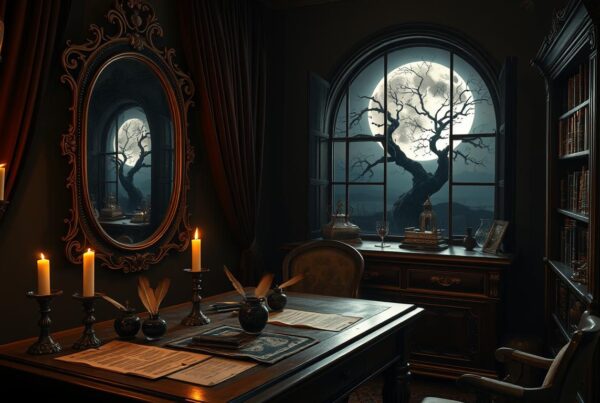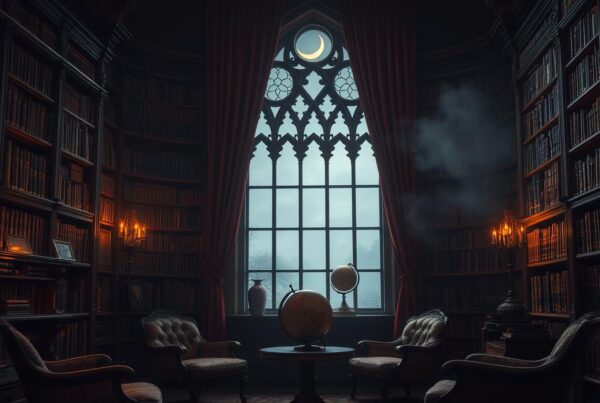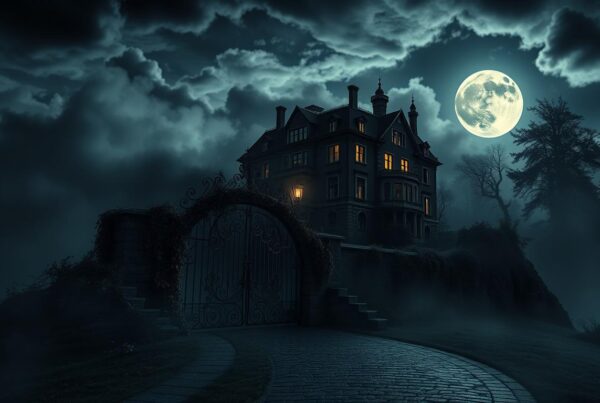Step into the shadowy world of Gothic literature. Here, dark romance and mysterious heroes are everywhere. This genre has thrilled readers for centuries with its mix of passion and fear.
Gothic romance is known for its haunted castles and supernatural elements. It’s a spell that’s hard to resist. In this spotlight, we’ll look at the brilliant minds behind these chilling tales.
These pioneers created stories that still inspire and haunt us today. Their works have shaped Gothic romance. They’ve left a rich legacy of atmospheric settings and unforgettable characters.
The Birth of Gothic Romance: A Literary Revolution
Gothic romance burst onto the literary scene in the late 18th century. It captured readers with its dark allure. This new genre emerged during a time of great change in 18th-century literature.
The romantic movement was in full swing. It inspired writers to explore emotions and imagination in their works.
The gothic fiction origins can be traced back to this period of artistic upheaval. Writers started to experiment with new storytelling techniques. They blended elements of romance, horror, and mystery.
They created atmospheric settings filled with crumbling castles, gloomy forests, and eerie mansions.
Readers of the time were hungry for something different. Gothic romance offered an escape from the rational world of the Enlightenment. It tapped into deep-seated fears and desires.
It explored the darker side of human nature. This new genre quickly gained popularity. It captivated audiences with its thrilling tales of love, terror, and the supernatural.
The impact of gothic romance on 18th-century literature was profound. It challenged traditional storytelling norms. It paved the way for new forms of artistic expression.
The genre’s influence can still be felt today. It can be seen in everything from horror movies to paranormal romance novels.
Horace Walpole: The Castle of Otranto and the Genesis of Gothic Fiction
Horace Walpole changed the literary world with his novel The Castle of Otranto. This book is widely recognized as the first gothic novel. It set the stage for a new genre that would captivate readers for centuries to come.
Walpole’s Innovative Narrative Techniques
Walpole’s writing style in The Castle of Otranto was groundbreaking. He mixed supernatural elements with realistic characters. This created a unique atmosphere of mystery and dread.
His use of ancient prophecies and family curses became staples of the gothic genre.
The Castle of Otranto’s Lasting Impact
The influence of Walpole’s work cannot be overstated. The Castle of Otranto inspired countless authors to explore gothic themes. Its legacy can be seen in modern horror and mystery novels.
This shows the enduring power of Walpole’s creation.
Walpole’s Personal Life and Writing
Horace Walpole’s personal experiences shaped his writing. His fascination with medieval architecture, evident in his home Strawberry Hill, directly influenced his gothic tale. This blend of personal passion and literary innovation made The Castle of Otranto a pivotal work in literature.
Ann Radcliffe: The Queen of Gothic Romance
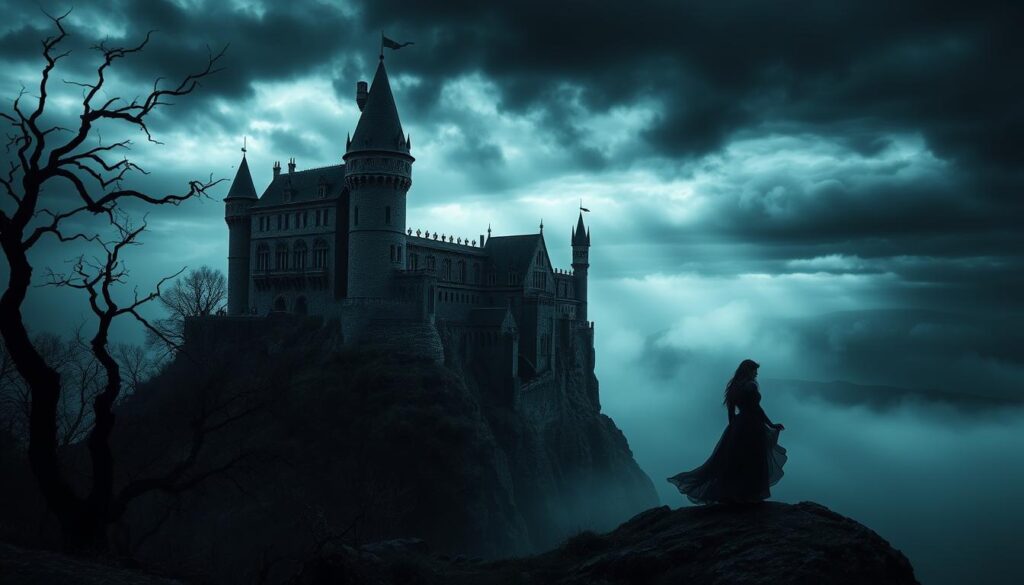
Ann Radcliffe was a trailblazer among female gothic writers. Her book, The Mysteries of Udolpho, was a hit with its mix of suspense and love. She stood out in a world mostly run by men in the late 18th century.
The Mysteries of Udolpho shows Radcliffe’s skill in setting scenes. She creates detailed landscapes and spooky castles that pull readers into her world. Her main character, Emily St. Aubert, goes through many challenges, keeping readers excited.
Radcliffe’s impact on Gothic stories is huge. She came up with the idea of the “explained supernatural,” where ghostly things have real reasons. This made her stories richer and inspired many writers after her.
As a top female gothic writer, Radcliffe opened doors for others. Her books are still loved and studied today. This makes her the true Queen of Gothic Romance.
Matthew Lewis: Controversy and The Monk
Matthew Lewis shocked readers with his novel, The Monk. Published in 1796, it was a scandalous tale. It pushed boundaries and changed the genre.
Shocking Elements
The Monk had explicit content. Lewis told a dark story of lust, violence, and supernatural horrors. His descriptions of sex and violence shocked people.
Innovative Writing Style
Lewis’s writing was unique. He mixed vivid images with fast action, making the story exciting. His use of complex plots and unreliable narrators made the story deeper.
Cultural Impact
The Monk had a big impact. It started debates on censorship and morality in books. Lewis’s work inspired others to write about darker themes.
Today, The Monk still fascinates readers and scholars. Its influence on gothic literature is clear. Matthew Lewis is a key figure in the genre.
Mary Shelley: Frankenstein and the Science Fiction Gothic
Mary Shelley’s novel, Frankenstein, is a key work in gothic literature. It was published in 1818. This book mixed gothic and science fiction, starting a new genre.
Shelley’s story is about Victor Frankenstein and his monster. It talks about ambition, being alone, and the dangers of too much science. The dark mood and deep thoughts are typical of gothic stories. But it also has science fiction ideas about making life.
Frankenstein makes us think about what it means to be human and the ethics of science. Shelley’s writing and characters have kept readers interested for over 200 years. She is a leader in both gothic and science fiction.
Frankenstein’s influence on culture is huge. It has led to many adaptations, like stage plays, films, and TV shows. Mary Shelley’s mix of horror and science still fascinates people today. Her work shows how timeless her vision is.
Edgar Allan Poe: The Master of Gothic Horror and Mystery
Edgar Allan Poe is a giant in Gothic horror. His stories mix scary tales with deep thoughts. Poe’s works pull readers in with their dark settings and complex characters.
Poe’s Unique Blend of Gothic and Detective Fiction
Poe started the detective genre with a Gothic twist. His character, C. Auguste Dupin, solved mysteries with logic in spooky places. This blend of reason and fear created a new kind of story.
The Psychological Depth in Poe’s Gothic Tales
Poe’s stories go deep into the human mind. He looks at fear, guilt, and madness in great detail. “The Tell-Tale Heart” and “The Fall of the House of Usher” show his skill in psychological thrillers. These stories uncover the dark sides of human nature.
Poe’s Influence on Modern Horror Literature
Poe’s effect on horror literature is huge. His focus on psychological terror has shaped the genre for many years. Today’s authors still get ideas from his scary stories and complex characters. Poe’s legacy is seen in many books, movies, and TV shows that explore human fear.
Emily Brontë: Wuthering Heights and the Romantic Gothic
Emily Brontë’s masterpiece, Wuthering Heights, is a top romantic gothic novel. It was published in 1847. This tale mixes passion, revenge, and the supernatural.
The story takes place on Yorkshire’s windswept moors. It’s a place both beautiful and eerie.
Wuthering Heights is about Catherine Earnshaw and Heathcliff’s love. Their love goes beyond social rules and even death. Brontë’s characters are deep and sometimes hard to understand.
The novel’s gothic side is clear. Wuthering Heights is far from the world, making it feel trapped and scary. There are ghostly scenes and dreams that mix reality with the supernatural.
Emily Brontë’s writing makes the story come alive. Her words paint the moors’ beauty and the characters’ inner struggles. This mix of romance and horror has kept readers hooked for years. It makes Wuthering Heights a classic in English literature.
Bram Stoker: Dracula and the Victorian Gothic Revival
Bram Stoker brought new life to Gothic literature with Dracula in 1897. This Irish author created a story that changed vampire fiction forever. His work came when Victorian society wanted dark, mysterious tales.
Dracula introduced us to Count Dracula, a vampire full of charm and fear. Stoker’s detailed descriptions and letter format pulled readers into a world of horror. The book’s hit sparked a new love for Gothic themes in Victorian readers.
Stoker mixed old Gothic styles with new fears. He tackled topics like sex, immigration, and science, showing Victorian worries. This mix made Dracula hit home with readers in many ways.
The effect of Dracula on culture is huge. Stoker’s character has inspired many stories in books, movies, and TV. Dracula’s lasting appeal has made it a key part of vampire fiction and Victorian Gothic.
Daphne du Maurier: Modern Gothic and Psychological Suspense
Daphne du Maurier is a key figure in modern gothic romance. Her stories mix deep psychology with spooky settings. This makes her tales unforgettable and engaging.
Rebecca: A Masterpiece of Gothic Suspense
Du Maurier’s most famous book is Rebecca. It shows her skill in creating suspenseful stories. The story is about a young woman who marries a rich man and moves to his big house, Manderley.
The ghost of his first wife, Rebecca, haunts the place. This creates a creepy mood that keeps readers guessing.
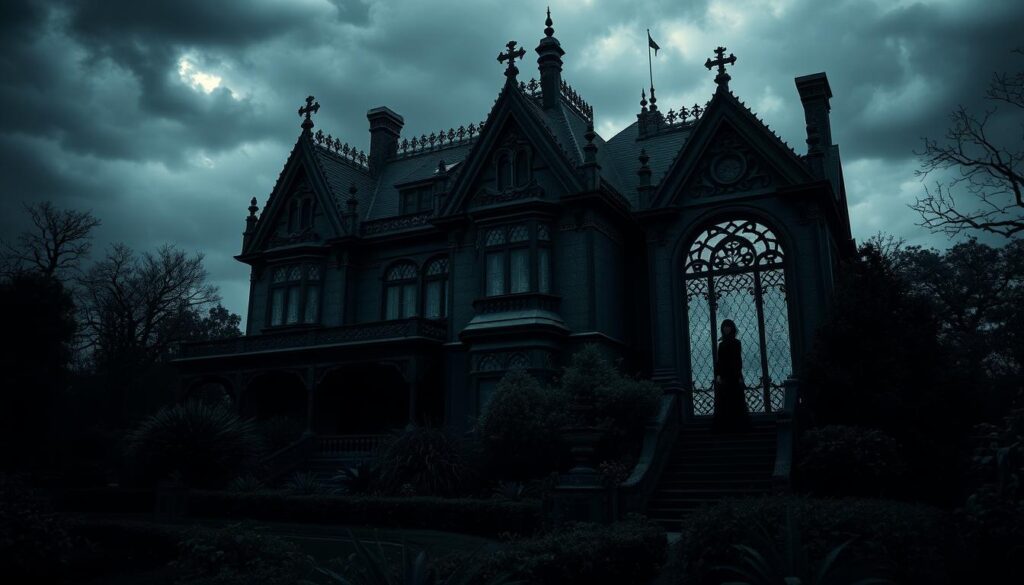
Du Maurier’s Unique Approach to Gothic Themes
Du Maurier gives old gothic themes a new twist. She swaps old castles for big houses and supernatural scares for mind games. This approach makes her stories appealing to today’s readers.
The Lasting Legacy of Du Maurier’s Gothic Works
Du Maurier’s impact is still felt today. Her skill in creating complex characters and settings has inspired many writers. Rebecca’s fame, with its many adaptations, shows how much people love her gothic tales.
The Enduring Influence of Gothic Romance on Contemporary Literature
Gothic romance has made a lasting impact on today’s literature. Writers like Ann Radcliffe and Edgar Allan Poe have inspired many. They mix old Gothic styles with new ideas, keeping readers excited.
Bestselling books show the Gothic influence. Stephen King and Anne Rice have made careers from Gothic stories. Their works show how Gothic themes tackle today’s fears and issues.
Young adult books are also filled with Gothic tales. “Twilight” by Stephenie Meyer and “Miss Peregrine’s Home for Peculiar Children” by Ransom Riggs are examples. These books bring Gothic stories to a new audience, keeping the genre alive.
The future of Gothic romance looks bright. It will keep showing our deepest fears and desires. Gothic stories, with their haunted places and mysteries, will always draw us in. This ensures Gothic romance’s lasting place in literature.

